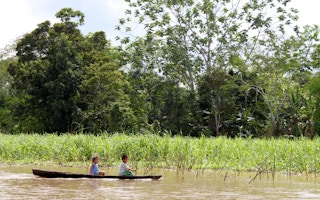Last week, I attended the second Global Bioeconomy Summit in Berlin. Bioeconomy is currently a hot topic for scientists and policymakers. Rapid advances in molecular biology combined with big data and artificial intelligence have resulted in big jumps in our understanding of living organisms as well as organic matter, the biomass produced by plants and animals, at the level of their DNA. That has gone hand in hand with technologies that allow scientists and industry to manipulate, easily, everything from enzymes to bacteria to plants and animals.
Bioeconomy: the 4th industrial revolution
Thus, industry can now make bio-based plastics from plant oils rather than fossil-based sources, for example. And those bio-based plastics can be made bio-degradable, even in oceans, or they can be made durable, to replace glass. In fact, pretty much anything made by the chemical industry could be made from bio-based sources, substituting fossil-based ones used primarily today.
Industry can also reproduce complex compounds found in nature, such as artemisinin, used to treat malaria. Or developed advanced biofuels that use grasses or algae for biofuels rather than sugarcane or corn. Or use bio-based sources for 3-D printing. So rapid are the changes in science and manufacturing, and so profound are its implications, that some refer to the new bio-economy, that uses bio-based sources for pretty much anything in our economy, as the 4th industrial revolution.
Our current agro-food system is the primary driver of planetary ill health
The traditional bioeconomy is not new—it is agriculture and forestry, or the agro-food system. Clearly, the current agro-food system is not sustainable. It produces roughly a quarter of greenhouse gas emissions causing climate change; has led to degraded soils in a very large share of cultivated land; is responsible for some 70 per cent of all water used by man and thus a key factor in water scarcity; overuses chemical fertilisers that causes massive pollution in rivers, lakes and coastal zones; and is responsible for the lion’s share of deforestation, loss of wetlands and biodiversity.
In short, our current agro-food system is the primary driver of our planet’s ill health—and it produces unhealthy food that has created 2 billion overweight and obese people with massive health problems.
Bioeconomy, climate change and energy security
My own contribution to the Summit assessed whether the new bioeconomy has the potential to strengthen the Paris Climate Agreement and energy security. My conclusion is that the answer to this question is also far from obvious. To begin with, our current bioeconomy is more part of the problem than the solution.
Avoiding deforestation
The most important natural climate change solution is to prevent deforestation, reforest, and restore peatlands. A good example is Colombia. Forty per cent of the country is part of the Amazon. This is 46 million hectares (the size of Germany) of land area, of which 39 million is still forest. Earlier in April, the Colombian and Norwegian governments agreed to extend the current forest conservation programme from 2020 to 2025, with an additional US$250 million contribution from Norway. A key component in the Colombian national green growth policy that GGGI is helping to develop is a modern, sustainable bioeconomy with a focus on activities ranging from biofuels with palm species to pharmacological compounds.
In Indonesia, GGGI supports the government to develop sustainable business models to restore the peatlands, also with Norwegian funding. Our analyses show that, for example, restoration of the 40,000ha Utar-Serapat peatland dome in Central Kalimantan would generate 600,000 tons of carbon credits. Even at a low $5/ton carbon, that could finance the peatland restoration in 10 years.
Can bioenergy strengthen the world’s energy security?
There just isn’t enough biomass available to do so sustainably, without competing with other uses, from food (for sugarcane or corn) to maintaining a healthy soil (for agri-waste). At smaller scales, locally, using biomass waste for energy makes a lot of sense and is already commercially attractive. Paper mills, for example, used to leave a large share of the wood pulp as waste, and use fossil fuel to power their machines.
In Vietnam, eight of the 41 sugar mills already have grid connected waste-to-energy plants. I visited one in Soc Trang province, which was expanded from 6 to 12 MW in 2014. GGGI hosted a workshop to assess the total biomass waste to energy potential in Soc Trang province, which may be as much as 50MW under one optimistic scenario. For Vietnam as a whole, the total potential of biomass energy, if all obstacles could be overcome, may be as high as 6000MW, or five coal-fired powerplants. Vietnam is planning to build another 24 coal fired power plants, however, and clearly biomass energy is not going to be an alternative source of renewable energy at that scale.
“
If the modern bioeconomy truly develops into the 4th industrial revolution, then many least developed countries are in a good position to take advantage and transform their economies towards an environmentally sustainable and socially inclusive development path to achieve green growth.
Traditional biomass energy
Of the estimated 19 per cent of renewable energy as part of total final energy consumption used in the world in 2015, about half is unsustainable traditional biomass energy such as fuelwood. Worldwide, an amazing 3 billion people still do not have access to clean energy for cooking, meaning that they prepare food on open woodfire. That leads to very poor indoor air quality which has a major health impact, particularly for women and children.
In Cambodia, 80 per cent of Cambodian families in rural areas use wood fuel (wood and charcoal) for daily cooking. The industry sector also uses around 780,000 ton of firewood annually. GGGI is now looking at ways to green the Cambodian industry as part of its policy alignment for green growth project.
Can the bioeconomy be a driver of green growth?
Avoided deforestation, reforestation, peatland restoration are key priorities for the green growth strategies of GGGI member countries such as Colombia, Indonesia and Ethiopia. Modern, sustainable bioeconomy can be a key strategy to make this successful, as is under way in Colombia.
In addition, for many of GGGI’s Member and partner countries, the traditional bioeconomy, agriculture and forestry, is still the backbone of the economy and responsible for 60-70 per cent of employment. For all these countries, innovation that significantly increases the value addition of their agricultural products sustainably or uses waste products smartly will be critical to create the decent green jobs.
It will be important for these countries to spot the opportunities early – to leapfrog their development rather than risk getting left behind. Such technology foresighting related to key areas of green growth-related innovation is an important goal for GGGI.
If the modern bioeconomy truly develops into the 4th industrial revolution, then many least developed countries are in a good position to take advantage and transform their economies towards an environmentally sustainable and socially inclusive development path to achieve green growth.
Dr. Frank Rijsberman is the Director-General of the Global Green Growth Institute (GGGI).











